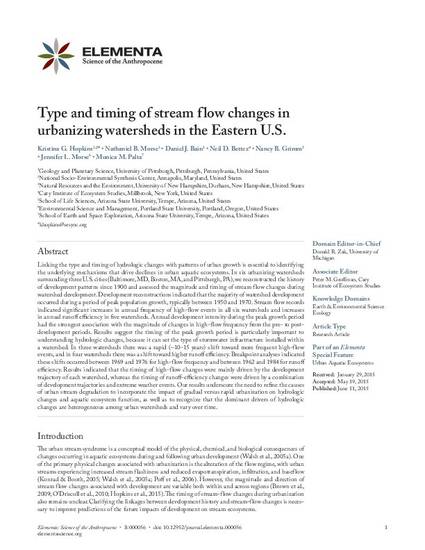
- Watershed management -- United States,
- Watershed hydrology -- United States
Linking the type and timing of hydrologic changes with patterns of urban growth is essential to identifying the underlying mechanisms that drive declines in urban aquatic ecosystems. In six urbanizing watersheds surrounding three U.S. cities (Baltimore, MD, Boston, MA, and Pittsburgh, PA), we reconstructed the history of development patterns since 1900 and assessed the magnitude and timing of stream flow changes during watershed development. Development reconstructions indicated that the majority of watershed development occurred during a period of peak population growth, typically between 1950 and 1970. Stream flow records indicated significant increases in annual frequency of high-flow events in all six watersheds and increases in annual runoff efficiency in five watersheds. Annual development intensity during the peak growth period had the strongest association with the magnitude of changes in high-flow frequency from the pre- to post-development periods. Results suggest the timing of the peak growth period is particularly important to understanding hydrologic changes, because it can set the type of stormwater infrastructure installed within a watershed. In three watersheds there was a rapid (~10-15 years) shift toward more frequent high-flow events, and in four watersheds there was a shift toward higher runoff efficiency. Breakpoint analyses indicated these shifts occurred between 1969 and 1976 for high-flow frequency and between 1962 and 1984 for runoff efficiency. Results indicated that the timing of high-flow changes were mainly driven by the development trajectory of each watershed, whereas the timing of runoff-efficiency changes were driven by a combination of development trajectories and extreme weather events. Our results underscore the need to refine the causes of urban stream degradation to incorporate the impact of gradual versus rapid urbanization on hydrologic changes and aquatic ecosystem function, as well as to recognize that the dominant drivers of hydrologic changes are heterogeneous among urban watersheds and vary over time.
© 2015 Hopkins et al.
This work is licensed under a Creative Commons Attribution 4.0 International License.
Article is available online at: http://dx.doi.org/10.12952/journal.elementa.000056
